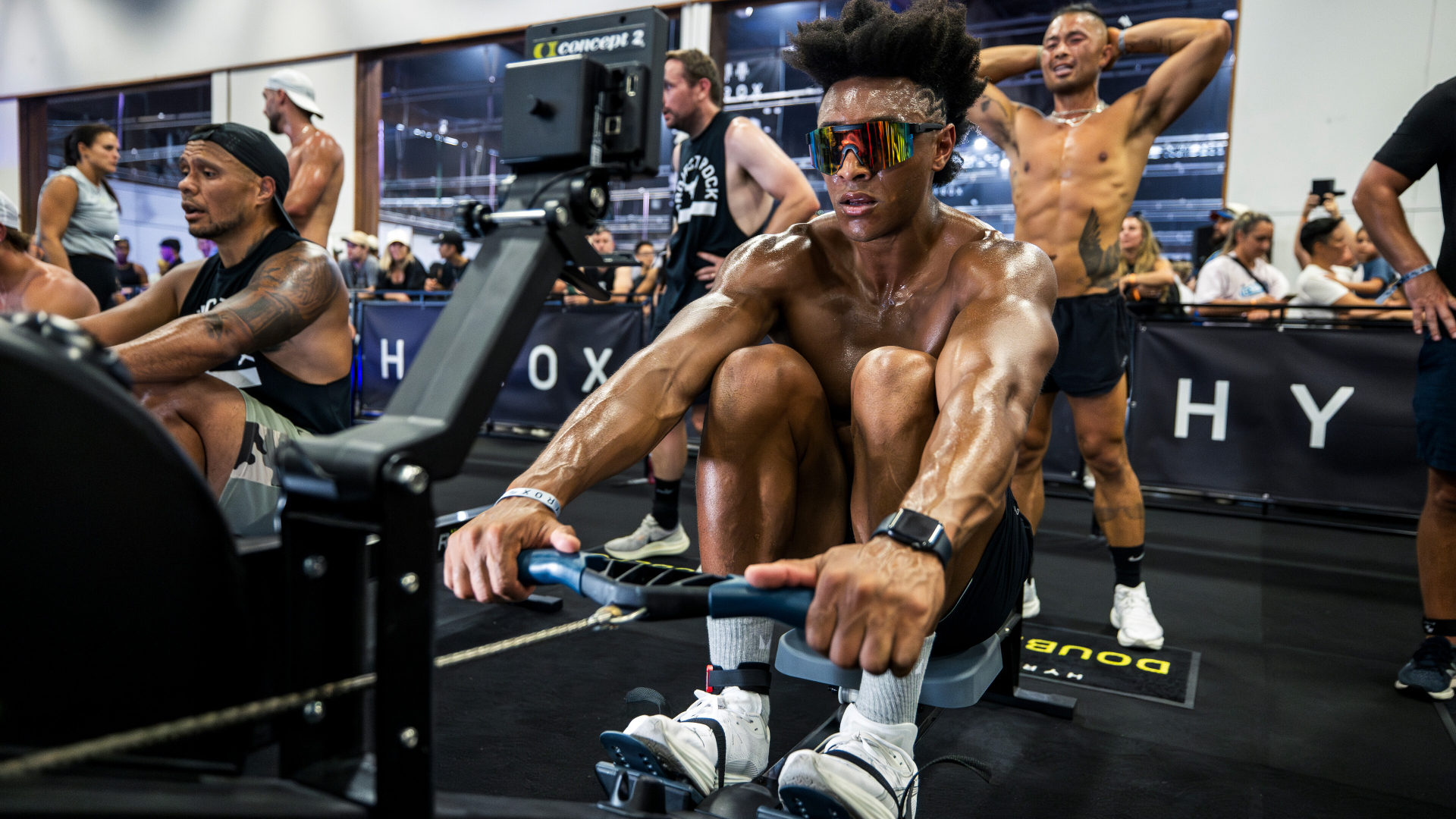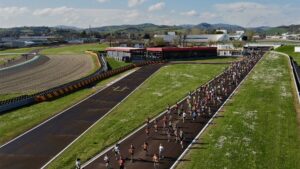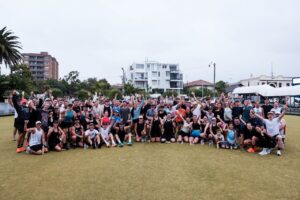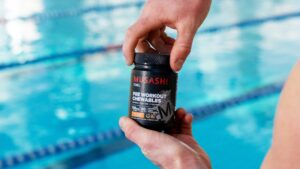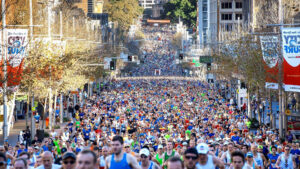A month into those New Year’s resolutions, the daunting reality of what you’ve overzealously agreed to has finally dawned upon you. And now you’re left wondering how the hell you’re supposed to be training for your maiden HYROX event (never mind surviving said maiden event).
We recently spoke with professional HYROX competitor, three-time F45 Playoffs champion, and fitness coach, Peter Day, as well as Kev Toonen, a strength and conditioning expert who’s worked with elite athletes such as the Cronulla Sharks and Sydney Roosters.
Here’s what all you rookies out there need to know.
Jump To:
The HYROX Format: Understanding What You’re Getting Into
The competition combines an eight-kilometre run achieved in single-kilometre splits between functional workout stations, as follows:
- Run (1,000 metres)
- SkiErg (1,000 metres)
The first HYROX workout station. This predominantly targets the arm, shoulder, and core muscles. However, when done efficiently, it also involves muscles in the lower body – making the SkiErg a full-body workout. - Run (1,000 metres)
- Sled Push (50 metres)
This is one station you do not want to come unprepared for… so make sure you try it out at least once before your race and invest in some grippy shoes! This movement targets the lower body muscles, including the entire posterior chain, core, and anterior thigh muscles in particular. - Run (1,000 metres)
- Sled Pull (50 metres)
Get ready to use your glutes, back, biceps, the entire trunk during workout station #3. - Run (1,000 metres)
- Burpee Broad Jump (80 metres)
Born in 1939, the fourth workout station is a full-body workout that is both loved and hated at the same time. Trying these for the first time may feel hard, but many of our regular athletes now consider this station to be one of their favourites! - Run (1,000 metres)
- Rowing (1,000 metres)
Station #5 is the second ergometer in this fitness race. Rowing marks the beginning of the second half of your HYROX race. - Run (1,000 metres)
- Farmers Carry (200 metres)
Engagement of your upper back muscles, core, and grip strength is required. - Run (1,000 metres)
- Sandbag Lunges (100 metres)
10, 20, or 30 kilograms on your back whilst lunging. Primarily targets the thigh and glute muscles, this one is a burner. - Run (1,000 metres)
- Wall Balls (75/100)
The final station: with the finish line in sight, finish your race in style.
[NOTE: Weights vary depending on gender and division.]
As you can imagine, it’s far easier said than done. But part of HYROX’s appeal is the accessibility, with an Open, Pro, Doubles, and four-person Team Relay category, true to its marketing, this is a race for everyone.
“HYROX seems to have nailed the format for a hybrid fitness racing event. It’s challenging, there are progressions for your top athletes, and it’s pretty inclusive for everyday gym-goers,” Peter Day told BH.
“It’s the closest thing I’ve seen to the perfect blend of strength, endurance, and conditioning in a fitness event. Pair that with world-class marketing, ‘Elite’ categories, team options, and a consistent format so you can benchmark your times at each event to track your progress.”
Day elaborated: “Logistically, the event is also perhaps the best I’ve seen in fitness, which allows for hundreds of competitors to take part in a weekend. And it’s something that people from nearly all gyms can enter.”
No Run, No Race
While HYROX is billed as a hybrid event that demands you push every aspect of your fitness, given how every single competitor must run the full eight kilometres no matter what category they enter (even in Team Relays), cardio is non-negotiable during the preparation stage.
“The biggest mistake I made in preparation was underestimating the running component of my training and the sheer engine you need to prepare for a race like this,” explained Peter Day.
“On paper, the event is half running, half stations. However, the running component seems to have the biggest impact on participants’ overall time.”
“That’s why the term ‘compromised running’ is thrown around a lot in HYROX, and it’s no surprise that the current top athletes in this sport are runners with the majority having a running background of some sort.”
On the adverse, one cannot solely rely on running ability, either. As you’ll soon discover, this requires a holistic approach to fitness.
Day continued: “You still need the strength to move fast and efficiently in the stations, but you have to have that engine to pull some fast kilometres each lap or you have no chance of being near the top.”
What is compromised running?
“Compromised running” essentially refers to running performed under fatigue, typically after completing a strength-based or high-intensity exercise i.e. precisely what’s involved with a HYROX event. As you will have gathered, running after such an activity is a completely different experience from “fresh running” (which is exactly what it sounds like).
The Blueprint
Structure & Consistency
“This is where something like the F45 HYROX Run Club can make a significant difference,” said Peter Day.
“It provides structured training that focuses specifically on the running component of HYROX, giving the guidance needed to build up endurance to tackle not just the eight kilometres on the day, but to be comfortable in running longer distances during training.”
Day admitted that even a professional such as himself found this “guidance” exceedingly helpful, adding:
“When I compared my weekly running volume to the Elite 15, I was significantly behind. I was originally doing 25 to 30-kilometre weeks, and the top athletes in this sport are clocking over 60-kilometre weeks on top of their strength and conditioning training.”
But unless you’re competing for a title, don’t worry too much about hitting those top-end benchmarks.
Day’s success at the F45 Playoffs makes him a fan of the company’s approach, but other big names in the HIIT world will offer similar quality training.
“The big thing is the consistency, so you need to make sure you’re training three to four days a week (at a minimum),” offered Kev Toonen.
“If you want to do well, you’ve really got to ratchet up the running… it’s also good from an injury prevention aspect as well (more on this later).”
“Progress isn’t about perfection, it’s about persistence. Keep moving forward, no matter how small the step.”
Balance
“The other common mistakes people make (especially during race week) are over-tapering for the event or doing too much strength on the days leading up,” noted Day.
“You may need to play around with your own body and how this works, but decreasing the intensity on race week without going too far is a challenge in itself, and the F45 HYROX Signature Workout Series helps manage this balance.”
“It complements the run club perfectly: a 13-week tailored program that includes regular F45 workouts along with a weekly HYROX workout, co-developed with the HYROX Sports team. This ensures you’re balancing the strength and endurance components necessary for the race.”
Toonen has also long championed the importance of strength training for runners – beyond the wheelhouse of HYROX.
As the man himself has outlined, aside from reducing the risk of injury by strengthening muscles, tendons, and ligaments for better shock absorption, you can also:
- Boost power and efficiency by enhancing neuromuscular coordination for more economical strides
- Support proper form by reinforcing the poster chain (glute, hamstrings, calves) to prevent fatigue-related breakdowns
- Enhance durability by building resilience against repetitive impact
- as well as improve speed (and stride power) with the right plyometrics and heavy compound lifts to really enhance that explosiveness
Accountability
There’s an entire myriad of psychological thoughts on this topic. Peter Day’s contention, however, is quite simple: load up that calendar with obligations and leverage our social/ego-centric instincts.
“I’ve always been a massive fan of entering fitness events throughout the year if you’re
looking to boost your motivation for training,” he said.
“In my experience, if you’re booked in for something like a HYROX with your gym bestie and all of a sudden, you’re eight weeks out, then you both start to naturally increase the intensity in the lead-up at, say, your F45 sessions.”
Nutrition
For an in-depth breakdown of HYROX-specific nutrition – from the training process to race day, including an example meal plan – check out this guide assembled by the fine folks over at AMRAP Antics.
But suffice it to say, you’re going to need plenty of complex carbohydrates for sustained energy without blood sugar spikes of crashes; plenty of protein to repair and rebuild muscle tissue; as well as healthy fats not just for energy production but hormone production and to assist with nutrient absorption.
We’ll update this section when we eventually solicit professional advice for an original take on a nebulous subject.
RELATED: So You’ve Signed Up For A Triathlon – Here’s Everything You Need To Know Before Race Day
Template HYROX Training Plan
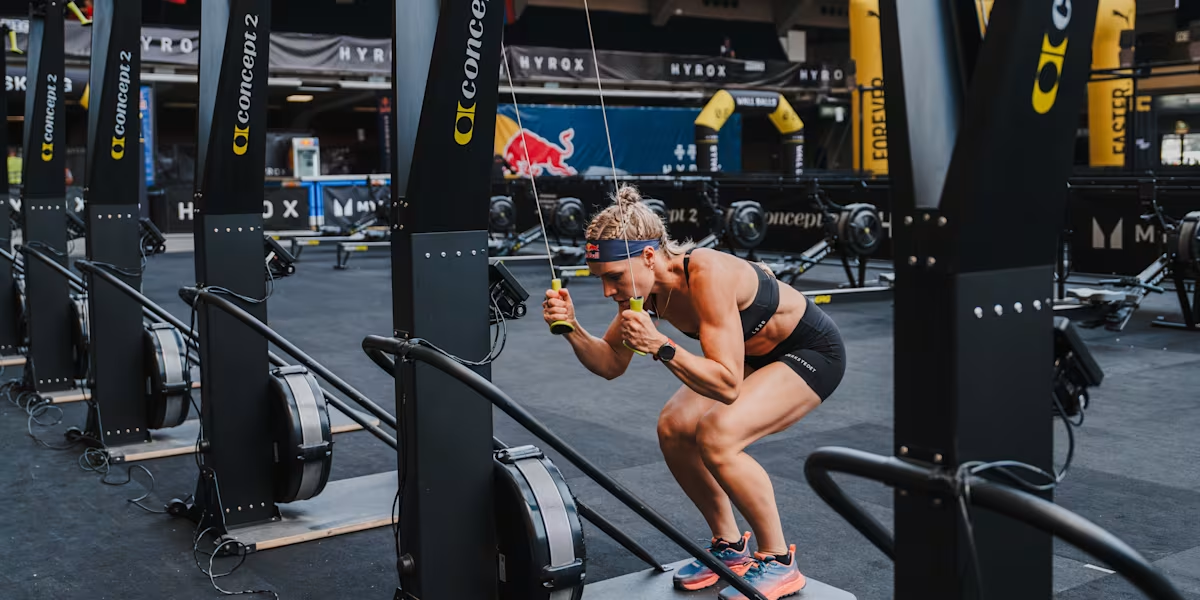
Follow at your own discretion. For a more dialled-in game plan, check out this periodised HYROX program designed by Kev Toonen, or check in with your local gym (like an F45) to see what resources are available.
Phase 1 – Building Your Fitness Foundation (Weeks 1-4)
Before you start worrying about sled pushes, you need to up that basic running endurance and general strength.
- Running
Three times per week (mix of steady-state and intervals)- Steady-State Runs
5-7 kilometres at a moderate pace to build aerobic capacity - Intervals
400-800 metre repeats at high intensity to improve speed and VO2 max - Hill Sprints
6-8 short sprints on an incline to develop leg power and endurance
- Steady-State Runs
- Strength
2-3 times per week (focus on compound lifts)- Squats & Deadlifts
Build lower-body strength and core stability - Pull-Ups & Rows
Upper body pulling strength for sled pulls - Overhead Press & Carries
Shoulder stability and grip endurance
- Squats & Deadlifts
- Zone-2 Cardio
Once per week (low-intensity, longer duration for endurance)- Rowing, cycling, or an hour-plus run at an easy pace
“Building that base 2-12 weeks out is absolutely pivotal to racing a good time. This would be the most important aspect of it all… you can’t fake it if you don’t put in the work!”
By the end of this stage, you should be reasonably comfortable running 3-5 kilometres in a single burst and lifting moderately heavy loads (relative to your body weight) without feeling completely broken.
Phase 2 – Functional Fitness (Weeks 5-8)
Now it’s time to begin simulating the crucible, as it were, with elements of what you’ll actually encounter on race day.
- HYROX Trial Sessions
Twice per week (run & functional station circuits)- E.g. Kilometre run + 50 wall balls → kilometre run + 100-metre sled push (Repeat 4-6 times)
- Transition practice: minimise rest between stations to get comfortable moving under fatigue
- Running
2-3 times per week (add some longer runs)- Increase distance to 7-10 kilometres at least once per week
- Add tempo runs (20-30 minutes at a hard but sustainable pace)
- Strength
1-2 times per week (maintain compound lifts, add sled work and carries)- Farmer’s Carries (grip and core strength)
- Heavy Sled Push/Pull (event-specific strength)
- Lunges & Step-Ups (leg strength and endurance)
Your workouts should start resembling mini-HYROX races. Soul-crushing afterburn and all.
Phase 3 – Peak Training (Weeks 9-12)
Around about now, you should be 90% ready (and right at home with the suffering). This is also when you shape your eventual race-day pace.
- Full HYROX Simulations
Once per week (recreate the full event)- Run the full 8 kilometres + all stations at your goal pace
- Focus on efficient transitions and pacing
- Running
2-3 times per week (speed work, endurance runs)- One interval session per week (e.g. 800-metre repeats at race pace)
- One longer run (8-12 kilometres at a steady pace)
- Strength & Functional Work
Twice per week (high-intensity circuits)- Incorporate sled pushes, burpees, rower intervals, and wall balls into circuits
- Keep reps and weights similar to race conditions
Push to your limits while being mindful of recovery – or else you’ll be out of the running before you even reach the start line.
The Most Underrated Recovery Tool
As counterintuitive as it may sound, in addition to the key pillars of hydration, proper nutrition, and the perennially overlooked sleep, a potent weapon for your arsenal is… more exercise (albeit at a relaxed pace).
“Workouts and runs that have a decreased intensity level,” revealed Peter Day.
“I train at a high frequency every week (about 10-12 sessions), but having workouts which I am purposely training in second gear, or running in a Zone-2 heart rate, is one of the best ways to still get your sessions in without over-stressing the body.”
“Your body physically can’t send it every workout, and nor should you. But undulating your weekly training from lower intensity sessions to high intensity ensures you continue to have progress, avoid plateaus, and ensure you get high-quality sessions in when training at volume.”
Though it’s worth mentioning one should always gauge the old equilibrium: if you’re genuinely wrecked, consider giving it a day and enjoying some couch time.
What To Expect On The Day
Under the bright lights and in the electric atmosphere of your fellow eager competitors, the adrenaline will certainly be high. Just remember to breathe or you’ll find defeat at your own hands (despite the months of preparation).
Fuelling up with a nutrient (though not physically) dense meal two to three hours beforehand is a must; allowing ample time for that nervous digestion to settle. Sufficiently hydrating throughout the day should also be a priority.
In terms of apparel, comfortable footwear with sufficient grip and stability for those sled pushes and pulls – ideally, the same pair you’ve trained in – should be on the checklist.
In terms of strategy, the prevailing wisdom dictates you should pace those early legs of running and circuits – don’t give in to the temptation of breaking single-kilometre or single-circuit PBs and risk emptying the gas tank before you can see the finish line in sight.
Turn it up around the sled pull station; and as counterintuitive as it may sound, take your time at the wall ball station (the final stop) to avoid potentially burning out completely. Cooked shoulders and all.
The most crucial thing to remember, however, is the real reason why you’re here: not to compete against everyone else (at least not strictly) but to compete against a former version of yourself. So relax and relish in the satisfaction that – assuming you’ve trained correctly – the HYROX journey has taken you this far, and the “war” has already been won.
“How you perform on the day doesn’t even matter,” reassured Peter Day.
“Don’t put too much pressure on the outcome of these fitness events – for the majority of people, it’s not as important as putting yourself out there. And the irony is they get less daunting the more you do… you always have the next one coming up!”
Also read:
- Henry Cavill’s Workout Routine Will Unleash Your Inner Superman
- Jake Gyllenhaal’s Workout & Diet Plan To Get ‘Road House’ Ripped
- Joe Rogan’s Workout & Diet Plan Isn’t For The Faint-Hearted
- The Chris Hemsworth Workout & Diet Plan Is Inhuman
- Paul Mescal’s Workout Will Get You ‘Gladiator 2’ Ripped
- Hugh Jackman Needed To Train For Six Months Before Returning As Wolverine For ‘Deadpool 3’
- Daniel Craig’s Military-Inspired Workout For ‘No Time To Die’
- How Michael Jordan’s Personal Trainer Helped Him Achieve GOAT Status
